Are you a Quiet Speculation member?
If not, now is a perfect time to join up! Our powerful tools, breaking-news analysis, and exclusive Discord channel will make sure you stay up to date and ahead of the curve.
Last week, I unveiled the first part of my Punishing Fire test. With the data compiled and revealed, it's time for the less-concrete part. The data is the data and speaks for itself. However, that's not the whole story. Magic isn't just a numbers game; there are a lot of intangibles. For instance, it's also supposed to be fun, which is where Punishing Fire might take an L.
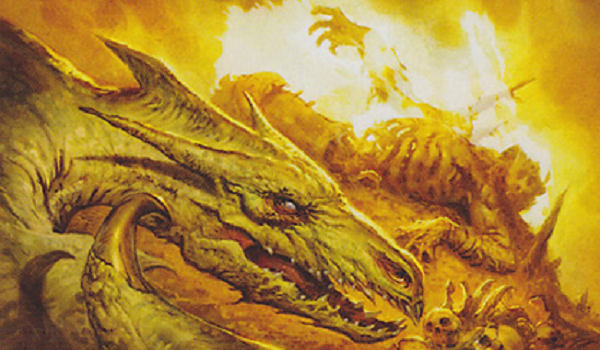
On Power
Starting off, I do not believe that the Punishing Fire/Grove of the Burnwillows combination is too powerful for Modern. Two recursive damage for three mana is fairly mediocre these days. Furthermore, Fire is mediocre on its own, because two damage doesn't kill as much as it used to; creatures have gotten much better in the 7.5 years since Fire was banned.
Fire is also balanced by deckbuilding requirements. To make Fire good, players must run Grove of the Burnwillows, a card with issues of its own. An early Grove will donate 4-5 life before the Fire engine can realistically get going, which generally translates into requiring an extra attack to win the game, giving opponents more time to find answers and come back.
Purely on raw power, there's no reason to keep Fire banned. However, if raw power or potential were the only factors determining a card's strength, Mox Amber and Smuggler's Copter would be Modern staples. Context is everything, and that's where Fire falters.
A Most Painful Experience
Testing Punishing Fire was not fun for me. Or for most of my team, for that matter. The problem is twofold. First of all, as I described last week, the games ran very long. Grove of the Burnwillows gives opponents life, and more life means needing more damage to win. Taking extra time isn't necessarily a bad thing, and many players lament Modern being a fast format. However, what they're really asking for is more matchups where more decisions are available and matter, and for more varied gameplay.
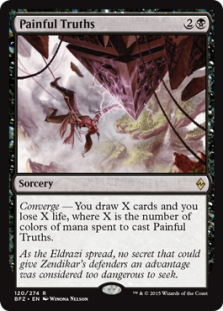 Fire is a fairly brainless card, and once the engine gets going, the whole thing plays itself. On my end, everything became very rote and mechanical. Every turn: throw some Fire at something, get it back, none of my other cards do anything at this point so say go, repeat until the game's over. My opponents either just kept doing what they were doing (Tron, Ironworks, sometimes Spirits) or were gradually snowed under with nothing to do (Humans, the other times with Spirits). Those games proved frustrating, tedious, and boring for opponents.
Fire is a fairly brainless card, and once the engine gets going, the whole thing plays itself. On my end, everything became very rote and mechanical. Every turn: throw some Fire at something, get it back, none of my other cards do anything at this point so say go, repeat until the game's over. My opponents either just kept doing what they were doing (Tron, Ironworks, sometimes Spirits) or were gradually snowed under with nothing to do (Humans, the other times with Spirits). Those games proved frustrating, tedious, and boring for opponents.
In addition, the Fire combo is incredibly slow. It takes forever to actually kill an opponent doing a net of one damage per turn. It takes several copies of the instant to present a decent clock, and that eats up all available mana very quickly, so I could never do anything else. Once we're locked into Firing out an opponent, there's nothing better to do. To make matters worse, the combo is very time intensive. Every cycle takes a lot of game actions, and even if you're quick about all of them, it adds up fast: tap two lands, cast Fire, mark damage, put Fire in graveyard; tap Grove, trigger Fire, mark lifegain; pay for the trigger, pick up the Fire. In short, endless busywork for both players as we tracked and performed every trigger and life change.
All in all, I would have rather traveled the River of Blood. At least in trial by painstik the agony is over quickly, this test was like months of water torture.
Not For Everyone
On the other hand, this is purely subjective. The UW pilot emphatically loved the whole thing, and to a rather creepy degree. Yes, I am calling him out on that. He loves grindy Magic, and going to time every round. He lamented when Sensei's Divining Top was banned in Legacy because there was nothing greater for him than winning game one of the Miracles mirror on turn 5 of extra turns via miracled Entreat the Angels on his opponent's end step. The matches where we ran over time, especially the ~95 minute one, are his favorite kinds of Magic games.
UW had to navigate every match very carefully, because Fiery Jund held the trump card in the Fire combo. It was not only a win condition by itself, but going long, it killed everything he could play and got there through counters. There's no way for planeswalkers to survive repeated attacks by several Fires.
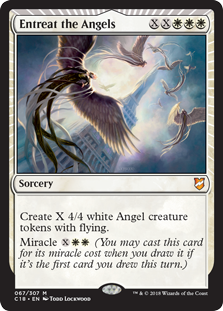 Everything that I found atrocious about Fire's gameplay, he embraced. Ideally, he wants every game to be a lengthy, close, hard to win/easy to lose grind fest that taxes him mentally and physically to the limit. Which was the reality of his test matches. He says that on his end, it was like playing a combination of 3D Chess and a Rubik's Cube using 90's adventure-game logic. Winning was mind-meltingly hard, and the correct lines were non-obvious and convoluted. While it won't be majority, there will be plenty of players that would genuinely enjoy playing against Fire in Modern.
Everything that I found atrocious about Fire's gameplay, he embraced. Ideally, he wants every game to be a lengthy, close, hard to win/easy to lose grind fest that taxes him mentally and physically to the limit. Which was the reality of his test matches. He says that on his end, it was like playing a combination of 3D Chess and a Rubik's Cube using 90's adventure-game logic. Winning was mind-meltingly hard, and the correct lines were non-obvious and convoluted. While it won't be majority, there will be plenty of players that would genuinely enjoy playing against Fire in Modern.
Impact
It is hard to asses the precise impact of a tested card in Modern. My test models the effect, but not perfectly; I can't test everything, and Modern is constantly shifting. However, it does give me a sense of how the cards play in the metagame. Based on my experiences, Punishing Fire would have a very different impact on Modern than I expected.
Not a Jund Card
Jund was not a great test platform for Fire. It was the only one available given that it's always been my policy to try the closest deck to the one that got the card banned. However, I've come to believe that Fire really isn't a Jund card anymore. It's a decent fit in Legacy Jund because Delver of Secrets and Young Pyromancer are format-defining cards, but Modern creatures tend to be more robust. Jund wins by grinding out value by playing 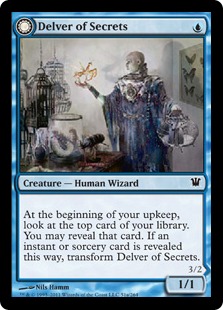 better cards at every stage of the game. Fire is never the best card; the value comes though continuous use. What Jund really wants to do is fire off a few disruption spells then start ramming home better threats to quickly close out the game. Going long is possible, but not its thing.
better cards at every stage of the game. Fire is never the best card; the value comes though continuous use. What Jund really wants to do is fire off a few disruption spells then start ramming home better threats to quickly close out the game. Going long is possible, but not its thing.
The other problem is that it was hard to reliably assemble the combo. Grove isn't fetchable, and the only card draw is the vulnerable Dark Confidant. This meant that most of the time, the game had to go long for the combo to come online. Even when it did happen in an average-length game, I had multiple Fires maybe 25% of the time. That's not a bad result, but I was acutely aware that I could have done better.
A Loam Home
If I had given myself perfect freedom in deck choice, I would have run the test with Assault Loam. Despite a very dedicated player base, Assault Loam is not a good Modern deck. The deck is inherently very slow and clunky because it is built around Life from the Loam. Unless it is dredging Loam every turn, few of Assault's cards are any good. Flame Jab and Raven's Crime are only devastating when used multiple times a turn, while the win conditions Seismic Assault and/or Zombie Infestation need lots of fodder, which can only be gotten through Loam. If it never finds Loam or loses its graveyard to Rest in Peace, Assault Loam is just a pile of weak cards. Even when it is dredging, it's hard to keep up with aggro decks.
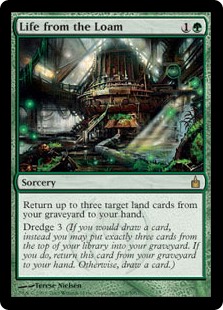 However, Punishing Fire could solve many Assault Loam's problems. As Legacy demonstrates, Loam naturally pairs with Fire. Dredging three is functionally identical to drawing three in the right deck (four if you count the Loam), translating into higher chances to find the combo. Loam decks struggle to miss land drops, so Assault Loam is more likely to be able to cast multiple Fires a turn and actually machine-gun down the creature decks.
However, Punishing Fire could solve many Assault Loam's problems. As Legacy demonstrates, Loam naturally pairs with Fire. Dredging three is functionally identical to drawing three in the right deck (four if you count the Loam), translating into higher chances to find the combo. Loam decks struggle to miss land drops, so Assault Loam is more likely to be able to cast multiple Fires a turn and actually machine-gun down the creature decks.
Fire also alleviates some of the deck's tension. As mentioned, the win conditions aren't lands. The namesake Assault is an enchantment, and most versions I've seen also have creatures and other enchantments. These can't be recurred with Loam if they're destroyed or dredged over. Again, Assault Loam needs to be dredging Loam to be good. However, that risks milling the win conditions. This isn't Legacy with Dark Depths and Glacial Chasm; Loam actually has to cast spells. Fire doesn't mind being milled, so there's less risk of self-sabotage.
Loam decks tend to be naturally slow decks. The problems with the Fire combo would persist in a Loam shell. As a result, an already-slow deck stands to get much slower and more popular from Fire's unban.
Against Creatures
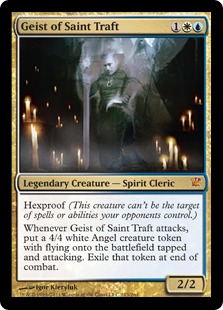 Based on the Spirits and Humans matchup, I don't expect Fire to be that great against creature decks. Back in 2011, creatures were so much worse that a repeatable two damage for three mana was oppressive. These days, we have rapidly growing 1/1s, hexproof creatures, and more cheap x/3s. A single Fire isn't that threatening. When multiple get going, it can be devastating. However, Magic has evolved enough that even a recursive four damage for five mana isn't that threatening for aggro decks. Decks like Merfolk would suffer, but they are struggling to stay relevant anyway. I think the anti-aggro argument isn't strong anymore.
Based on the Spirits and Humans matchup, I don't expect Fire to be that great against creature decks. Back in 2011, creatures were so much worse that a repeatable two damage for three mana was oppressive. These days, we have rapidly growing 1/1s, hexproof creatures, and more cheap x/3s. A single Fire isn't that threatening. When multiple get going, it can be devastating. However, Magic has evolved enough that even a recursive four damage for five mana isn't that threatening for aggro decks. Decks like Merfolk would suffer, but they are struggling to stay relevant anyway. I think the anti-aggro argument isn't strong anymore.
Against Fair Decks
The surprising effect was against UW Control. I didn't appreciate or expect the impact Fire has on fair matchups. Decks that rely on small numbers of win conditions or attrition will be heavily impacted, because over the long game, the Fire combo can't be out-grinded. So long as there's a single Grove, Fire is always live. Closing the vulnerability to Field of Ruin is another reason to pair Fire with Loam. The game ends up being warped around Fire.
Usage
Should Fire be unbanned, its synergy with Loam is too great to not go into Loam decks. This will greatly improve their control and midrange matchups. This ensures that absent graveyard hate, the Loam deck can never be exhausted, and will eventually win. Because the 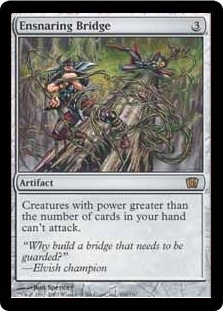 combo is very slow, this will lengthen matches. Post-board, graveyard hate becomes essential. Against aggro decks, Loam potentially gets an improved Flame Jab to protect itself. It's hard to believe it turns the matchup around, but would stretch the game out and make aggro work harder.
combo is very slow, this will lengthen matches. Post-board, graveyard hate becomes essential. Against aggro decks, Loam potentially gets an improved Flame Jab to protect itself. It's hard to believe it turns the matchup around, but would stretch the game out and make aggro work harder.
The other concern is if a deck really embraces Fire, and what it represents. Fire's gameplay is reminiscent of Loam-centric prison decks like CAL. I don't know if something similar is possible, but if not, Fire does lend itself very nicely to Ensnaring Bridge strategies: players can use Fire early to buy time, then hide behind Bridge and plink away to their heart's content. Fire may not actually be a Jund card, but it's almost certainly a prison card.
The Dance
There's also some weirdness concerning the Fire combo's mechanics. The recursion is a triggered ability, and it is triggered by a mana ability. This means, just like with Krark-Clan Ironworks, as long as Grove is untapped, Fire isn't vulnerable to Extirpate or Surgical Extraction. This specific situation never came up in my testing because no test deck ran Extraction, however I've seen it happen in Legacy. I call it the dance.
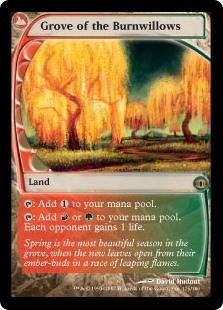 The Fire player has an untapped Grove and Fire in the graveyard. Their opponent has Extraction. The opponent can't just Extract the Fire, because in response, Grove will save it. Fire also can't just be retrieved, because there's only one Grove and one trigger. So both players enter into a standoff, trying to force an opening. The opponent is looking to force Fire to tap the Grove; Fire hopes to present a more pressing target for the Extraction. As a mental game, it is fascinating and enjoyable. However, it also tends to extend match length, since both players have to carefully and continually consider their moves and their opponent's counter moves while assessing whether to continue the dance.
The Fire player has an untapped Grove and Fire in the graveyard. Their opponent has Extraction. The opponent can't just Extract the Fire, because in response, Grove will save it. Fire also can't just be retrieved, because there's only one Grove and one trigger. So both players enter into a standoff, trying to force an opening. The opponent is looking to force Fire to tap the Grove; Fire hopes to present a more pressing target for the Extraction. As a mental game, it is fascinating and enjoyable. However, it also tends to extend match length, since both players have to carefully and continually consider their moves and their opponent's counter moves while assessing whether to continue the dance.
My testing did have some versions of the dance, this time with Relic of Progenitus and Field of Ruin/Ghost Quarter. In the former, it was about keeping enough chaff in the graveyard to feed the Relic until either another Grove was found or Tron tapped out. In the latter, it was about holding Grove until it was actually time to get back Fire. Both created abnormal play patterns.
Holding lands to play around destruction spells felt bad, though it was strategically sound. Against UW, it was critical to preserve Groves to maintain inevitability. However, that often meant I had to skip land drops or play tapped lands when faced with Field. Generally speaking, players dislike this type of gameplay and Wizards doesn't like encouraging it.
Final Assessment
The data showed that Fire didn't improve Jund's win percentage very much. It also showed that Fire significantly increased how long matches took. There's reason to believe that Fire would slot into already-slow decks, and explicitly serves to lengthen games. I and most of my team disliked the actual gameplay. Therefore, I don't think there's much to gain from unbanning Fire, and as a result, would keep it banned.
Amongst Colleagues
Cards that drag out games get banned when they get too popular and/or significantly impact tournament length. Second Sunrise was banned for the later problem. Sensei's Divining Top was first banned in Extended for dragging out games, preemptively banned in Modern on the assumption it would do so again, and recently banned in Legacy both time problems and popularity. My experience says that executing Fire combo is mechanically very similar to spinning Top every turn. Therefore, I think it's fair to include Fire in the "Banned for Tournament Length" category rather than being overpowered.
Again, power-level wise, there's nothing onerous about Fire combo. It seemed fairly mediocre given the improvement in creatures since 2011, though its potential against fair decks is impressive. However, it creates, rewards, and requires repetitive, lengthy play patterns which would eat into tournament time. This also leads to games feeling very similar and mechanical, which many don't find that fun. Given Wizards' history with Top, I doubt that they'd want to take the risk of Fire getting popular enough to consistently stretch out tournaments and will keep it banned.
The Comparison
The Thopter Foundry/Sword of the Meek combo is a potential counterpoint. This combo also has a lot of moving parts and doesn't directly win the game. It makes lots of 1/1 fliers and tries to overwhelm opponents while shutting down aggressive decks and out-grinding fair decks. On face, it's very similar to Fire combo.
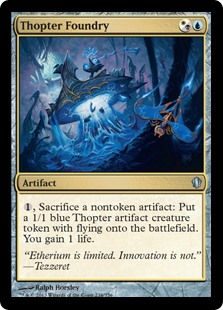 However, the Thopter combo has two saving graces. The first is that it is cleanly shortcutable: You simply declare how many tokens you're making at a time, skip going through all the steps, and gain life in a lump sum. You can't just declare a Fire loop; you do have to go through most of the motions. You can shortcut the triggers, but you will have to actually cast the Fire(s) and mark all the life total changes individually for proper tournament procedure. Also, there's no timing weirdness with Thopter combo.
However, the Thopter combo has two saving graces. The first is that it is cleanly shortcutable: You simply declare how many tokens you're making at a time, skip going through all the steps, and gain life in a lump sum. You can't just declare a Fire loop; you do have to go through most of the motions. You can shortcut the triggers, but you will have to actually cast the Fire(s) and mark all the life total changes individually for proper tournament procedure. Also, there's no timing weirdness with Thopter combo.
Secondly and most importantly, Thopter combo actually wins the game very quickly. The tokens persist, and it often only takes two turns of dumping mana into Foundry to generate a lethal airforce, even if a few have to chump block. Fire can't win quickly except by concession. Besides, Fire's is a combo that interacts, thereby extending the game by purpose, while Thopter's proacts, seeking instead to put games away. As a result, the comparison is only superficial, and doesn't really improve Fire's chances.
Fun > Boredom
Magic is a game and supposed to be fun. My experience with Fire in Jund was not fun. I have evidence that unbanning Fire would reduce Modern's available fun by making tournaments drag on. More than any power considerations, that notion makes me think Punishing Fire should stay banned.





While I don’t particularly want to see Punishing Fire in Modern, I can’t help but notice a pattern to these tests. I’ve read all of your banlist test articles over the years, and while I haven’t gone back now to verify that there isn’t an exception I’ve forgotten, every single test ends the same way: the numbers don’t provide a compelling argument to keep the card banned, but you argue for it to stay banned anyway based on the intangibles.
Don’t get me wrong, I think it’s fantastic that you’re putting in the time and effort to test all these cards, but as time goes on I find myself having more and more trouble taking your qualitative assessments seriously. You advocated for keeping BBE, JTMS, and Sword of the Meek banned, none of which broke Modern by any stretch of the imagination. Jace is certainly good, but arguably worse the Teferi in most builds, Jund still isn’t much of a deck and the Thopter/Sword combo was basically never good enough to make an impact. Based on that, how can we determine that SFM, GSZ or Punishing Fire can’t come off? Again, please don’t take this personally, I just feel like it’s something worth pointing out after this pattern has repeated itself once again.
If there’s a pattern, that’s because that’s just how it works out. There’s a lot more to these tests than pure matchup numbers. Sometimes it’s the things that you can’t see that are the problem.
I also take a more cautious approach with the cards. Preordain had no measurable impact and felt about the same as Sleight of Hand, so I didn’t have a problem with unbanning it, though I also said it was a non-starter since Opt was reprinted. With Jace, Stoneforge, and BBE the issue I found in testing was that their impact was limited to fair matchups. They were good enough there that I couldn’t think of a reason that fair decks wouldn’t be built around them, and so they would impact diversity. They could also incentivize decks to be more unfair to avoid their impact. Given the unfairness in the format at the time they were tested, I considered the risk of incentivizing unfairness too high compared to the potential boost to the fair homes for the cards. I was looking for the overall impact and arguing about whether the expected change could be healthy.
I also can’t predict how things will actually shake out in the metagame. These days Jace is in every control deck, as I predicted, but he’s played in addition to Teferi. Which is actually better is up for debate, though the fact that Jace is generally a 3-of to Teferi’s 2 is suggestive. The only reason Jund isn’t the BGx deck of choice is Tron’s everywhere and Field of Ruin is necessary. I never tested Thopter Sword, I was just going off of instinct and history. Had I done any testing, the fact that it’s mediocre at best would have been readily apparent, and I recall outright stating that somewhere. As for GSZ, I’m fairly certain it did have a substantial impact on Elves’ win percentage despite the fact that the deck wasn’t optimally built. This is a strong indication that the card is actually busted.
With Fire there was no concrete data saying that it has an impact on win percentage. However, I have strong data saying that it drags out games. Given history, cards that do that well and consistently are cards that get and stay banned. That is a data driven result and a reason to keep Fire banned. The fact that I was nearly bored to death is mostly ancilary.
Hey David,
Saw the writing on the wall with this one, right from the start. It’s great that you’re doing this work for the community.
However, would it be fair to say that you’re presenting a final conclusion as something objective, when really this is an opinion piece?
It’s no secret throughout your writing here that the undercurrent for this entire piece of work was a lack of enjoyment, or even boredom. It’s mentioned numerous times and sort of deflates the tone of the whole piece. By the end of the first article, I already knew what you were going to say, not based on any data or analysis but just from your lack of enjoyment, which I think it’s fair to say, became the primary factor in your roundup at the end.
There’s nothing wrong with expressing an opinion, and actually as an audience member, we like opinions and personal stories. It’s fun! However I think there’s a misstep somewhere with this series, which appears to be trying very hard to make solid,verifiable conclusions or recommendations from mountains of testing data.
I’m sure there’s a comfortable compromise here actually. Something as simple as “here’s the objective results” and “here’s my personal opinion” and while your writing does make efforts to create this distinction once or twice, it’s not consistent throughout all the articles. Your apparent misery at having to playtest this card sort of permeates the whole thing, whereas it would have perhaps been the better structural decision to leave that part out, except for an emotive, opinion summary at the end which could give everyone a bit of personal narrative about your feelings on the whole thing. Y’know, like the end of a Scrubs episode or something hahaha.
Anyway I hope you can see that I’m a fan, I enjoy your writing and your efforts, but this one (even as a reader) felt like a slog, and it didn’t need to. Even if the testing was long or arduous, I think that stuff needs to be encapsulated somehow, ring-fenced from the bulk of the analysis. Is that fair? Maybe you agree, maybe you don’t. That’s fine either way =).
‘A’ for effort. You’re a trooper.